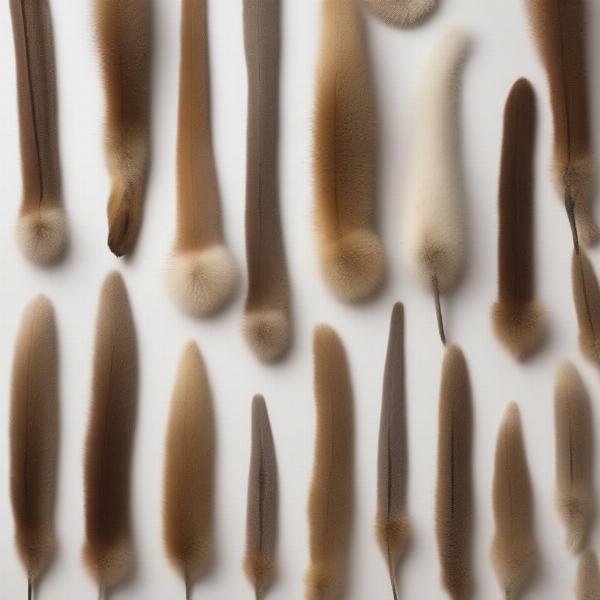Kangaroo tails for dogs have become increasingly popular as a natural, long-lasting chew treat. But are they the right choice for your furry friend? This guide dives deep into the benefits and potential drawbacks of kangaroo tails for dogs, offering practical advice on selection, feeding, and safety. We’ll explore everything you need to know to make an informed decision about incorporating this unique treat into your dog’s diet.
Nutritional Benefits of Kangaroo Tails for Dogs
Kangaroo meat is known for being lean and rich in protein. This translates to a healthy, low-fat chew for your dog. Kangaroo tails are also a good source of essential nutrients like zinc and iron, which contribute to a healthy coat, strong immune system, and overall well-being. They are also naturally hypoallergenic, making them a suitable option for dogs with sensitive stomachs or food allergies. Because they are a single-ingredient treat, they avoid many of the fillers and additives found in processed dog chews.
Choosing the Right Kangaroo Tail for Your Dog
Kangaroo tails are available in various sizes, from small pieces suitable for puppies and small breeds to large, whole tails for larger dogs. Choosing the correct size is crucial for preventing choking hazards. Always supervise your dog when they are enjoying a kangaroo tail. Look for tails that are naturally dried or air-dried, as these methods preserve the nutritional value and avoid unnecessary chemicals. Avoid tails that are heavily processed or contain artificial preservatives.
Are Kangaroo Tails Safe for My Dog?
Like any chew treat, kangaroo tails should be given in moderation. While they offer several health benefits, they are not meant to replace a balanced diet. Overconsumption can lead to digestive upset or weight gain. Always monitor your dog for any signs of discomfort or allergic reactions, although rare. One common concern is the potential for salmonella contamination. Choose reputable suppliers who prioritize hygiene and safety standards to minimize this risk.
How to Feed Kangaroo Tails to Your Dog
Introduce kangaroo tails gradually to your dog’s diet, starting with smaller pieces. Observe their chewing habits and ensure they don’t try to swallow large chunks. For puppies and senior dogs, you may need to soften the tail by soaking it in warm water for a short period. This can make it easier for them to chew and digest. Never cook kangaroo tails, as this can make them brittle and increase the risk of splintering. Always provide fresh water alongside the chew.
Kangaroo Tails vs. Other Chew Treats
Compared to rawhide, kangaroo tails are generally considered a safer and healthier alternative. Rawhide can be difficult to digest and pose a choking hazard. kangaroo tail for dogs also offer a longer-lasting chew experience than many other treats, keeping your dog occupied and satisfied. While they might be slightly more expensive than some chews, the nutritional benefits and longevity make them a worthwhile investment for your dog’s health and happiness.
 Different Sizes of Kangaroo Tails
Different Sizes of Kangaroo Tails
Conclusion
Kangaroo tails can be a valuable addition to your dog’s treat repertoire, providing a nutritious, long-lasting chew that promotes dental health and overall well-being. By following the guidelines outlined in this article, you can safely and effectively incorporate this unique treat into your dog’s diet, providing them with a healthy and enjoyable chewing experience. Remember to choose high-quality tails, monitor your dog’s consumption, and always prioritize their safety and health.
FAQ
- Are kangaroo tails good for puppies? Yes, but choose small pieces and supervise closely. Soaking the tail in warm water can make it easier for them to chew.
- Can kangaroo tails cause allergies? Kangaroo is hypoallergenic, making allergic reactions rare.
- How often can I give my dog a kangaroo tail? In moderation. They are a treat, not a meal replacement.
- What if my dog swallows a large piece? Contact your vet immediately if you suspect your dog is choking or experiencing digestive blockage.
- Where can I buy high-quality kangaroo tails? Look for reputable pet supply stores or online retailers that specialize in natural dog treats.
- Are kangaroo tails messy? They can be slightly messy, so consider giving them to your dog outdoors or on an easy-to-clean surface.
- Can kangaroo tails help with teething puppies? Yes, the chewing action can help soothe sore gums.
Related Articles
ILM Dog is your trusted resource for expert advice on dog care and nutrition. We provide practical, reliable information on everything from breed selection and puppy care to senior dog health and training. We are committed to helping you provide the best possible care for your furry companion. For personalized advice and recommendations, contact our team of experts at [email protected] or call us at +44 20-3965-8624. Visit ILM Dog for more information.